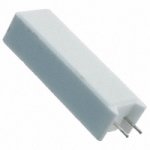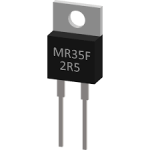Edit.mpc71.
Those are getting hard to find in North America. TO220 are getting more popular.
Yes i see,but those(TO220) are very expensive.Those are getting hard to find in North America. TO220 are getting more popular.
yes the are thimios I was checking cost, and this one is 5mm LS 7W and $0.64 cents part number 2-1623789-1 also 2-1623788-5 5W $0.57 cents 🙂
Attachments
Last edited:
Yes i see,but those(TO220) are very expensive.
$0.20 here. CVW5R220JLF - INTERNATIONAL RESISTIVE - WIREWOUND RESISTOR, 0.22 OHM, 5W, 5% | Newark element14. Almost impossible to find in metal film though.
$0.20 here. CVW5R220JLF - INTERNATIONAL RESISTIVE - WIREWOUND RESISTOR, 0.22 OHM, 5W, 5% | Newark element14. Almost impossible to find in metal film though.
even better 🙂
What's with all these exotic packages ?
Wirewound or metal film 15 and 20mm LS 3-5W - available everywhere.
The standard wirewounds have a few hundred picohenries inductance.
They won't affect operation until a few Mhz.
Metal films are a bit better , but still have both inductance + C ,
less powerful.
Bifilar and Ayrton-perry military wirewounds are the best - both 15 and
20mm one go for 1.50 - 2.71 EACH !!
Lot's of choices in the standard axial resistors. Spend up to $27.10 on
just the Re (Vishay MRA series). Vishay - MRA - Wirewound Resistors, Non-Magnetic, Non-Inductive, Axial Lead .
"Fanatics" , for sure !
OS
Wirewound or metal film 15 and 20mm LS 3-5W - available everywhere.
The standard wirewounds have a few hundred picohenries inductance.
They won't affect operation until a few Mhz.
Metal films are a bit better , but still have both inductance + C ,
less powerful.
Bifilar and Ayrton-perry military wirewounds are the best - both 15 and
20mm one go for 1.50 - 2.71 EACH !!
Lot's of choices in the standard axial resistors. Spend up to $27.10 on
just the Re (Vishay MRA series). Vishay - MRA - Wirewound Resistors, Non-Magnetic, Non-Inductive, Axial Lead .
"Fanatics" , for sure !
OS
Last edited:
I don't mean what you post here.yes the are thimios I was checking cost, and this one is 5mm LS 7W and $0.64 cents part number 2-1623789-1 also 2-1623788-5 5W $0.57 cents 🙂
TO220 resistors like this in picture are expensive
Attachments
oh yes they are sorry I misunderstood, well that will depend on the builder the most important thing is flexibility to chose components according to personal preference and having the layout with more than one options is a plus  🙂
🙂
 🙂
🙂I don't mean what you post here.
TO220 resistors like this in picture are expensive
I think those are meant to mount on a heat sink. Jason's layout fits the ceramic version.
Yes they will be mount on a heat sink if the goal is the maximum power 25w.I think those are meant to mount on a heat sink. Jason's layout fits the ceramic version.
Yes, radial lead ceramic. Readily available at reasonable prices. Nothing exotic. The spacing WOULD support the fancy TO-220 devices if someone wanted to be spendy.
Edit.mpc71.
... better use MPC74 as specifically designed for audio.
9mm lead spacing too.
They are available in Europe via e.g. conrad.com
Available Values are 0.1, 0.22, 0.47R@5W
BR, Toni
Please post a link to the thread about the super protection PCB
Please post a link to the thread about the super protection PCB. I'm interested in this topic. Love this thread.😀
Please post a link to the thread about the super protection PCB. I'm interested in this topic. Love this thread.😀
Absolutely the best inrush , DC , overcurrent , thermal "all in one" -
http://www.diyaudio.com/forums/solid-state/264313-how-build-21-st-century-protection-board.html
Buried 12 pages back - sometimes I wonder about the priorities
in the DIYA world. More threads about rollin' caps and op-amps. 😕
OS
http://www.diyaudio.com/forums/solid-state/264313-how-build-21-st-century-protection-board.html
Buried 12 pages back - sometimes I wonder about the priorities
in the DIYA world. More threads about rollin' caps and op-amps. 😕
OS
Latest Krell Amps appear to be CFA, and use a tracking "iBias circuit" to maintain ClassA operation. Rear cooling fans are present to support smaller, HT rack mount format. The pending patents appear to still be unpublished. I suspect that transistor array chips are used for tight tolerance multi-output current mirrors.
------
Circuitry Highlights
The new iBias circuitry is built on a foundation of core Krell circuit technologies. All signal gain is realized in the current domain using proprietary multiple-output current mirrors with extraordinary open loop linearity. Each amplifier channel uses all discrete components. There are no generic integrated circuits or op amps used anywhere. Gain is distributed among several stages, allowing each to have a large linear operating area.
Audio signal voltages are converted to current at the amplifier input, and the audio signal remains in the current domain throughout the entire amplifier.
Current mirrors in the final gain stages use a new output power device that operates at a 73% higher voltage, delivers almost 10% more current, and offers 120 watts of additional power handling capability as compared to other devices.
With this combination, the iBias amplifiers may now deliver substantially more power while using a smaller footprint. Normally used in demanding, high-bandwidth video circuits, these transistors allow the design of gain stages with superb accuracy and very low distortion. The signal path is fully complementary and fully balanced from input to output. Independent complementary pre driver and driver stages for the positive and negative output transistors make the output stages extremely fast and linear. This unique circuit is impervious to low-impedance or reactive loads; it simply drives any loudspeaker with absolute confidence, achieving the very best possible sonic results.
Most amplifiers use coupling capacitors in the signal path to block DC and prevent damaging offset voltages from reaching your speakers. Krell amplifiers are fully direct-coupled, with no capacitors in the audio signal path. This design gives the Krell amplifiers lower internal impedance, which allows firmer, more precise control of your speakers. It also provides flatter, more extended low-frequency response, because coupling capacitors not only block DC but also affect the lowest bass frequencies. Krell employs expensive, non intrusive DC servos that remove DC without impacting the musical signal. Thus, the iBias Class A amplifiers deliver the full breadth of the music with detail, impact, and space intact.
Network connectivity brings convenience, monitoring, and reporting to end users from any smartphone, tablet, or laptop. Amplifier configuration options include display brightness and timeout. For energy conservation, the amplifiers can be programmed to power off at a preset time of inactivity. Individual channels can be muted and firmware updates can be initiated from the web server. Excessive current, output DC, fan speeds, short circuit, and overheating are all monitored in real time. Messages are displayed on the front panel and reported on the web server interface. Additionally. end users can be sent an email notifying them of any operational anomalies.
------
Circuitry Highlights
The new iBias circuitry is built on a foundation of core Krell circuit technologies. All signal gain is realized in the current domain using proprietary multiple-output current mirrors with extraordinary open loop linearity. Each amplifier channel uses all discrete components. There are no generic integrated circuits or op amps used anywhere. Gain is distributed among several stages, allowing each to have a large linear operating area.
Audio signal voltages are converted to current at the amplifier input, and the audio signal remains in the current domain throughout the entire amplifier.
Current mirrors in the final gain stages use a new output power device that operates at a 73% higher voltage, delivers almost 10% more current, and offers 120 watts of additional power handling capability as compared to other devices.
With this combination, the iBias amplifiers may now deliver substantially more power while using a smaller footprint. Normally used in demanding, high-bandwidth video circuits, these transistors allow the design of gain stages with superb accuracy and very low distortion. The signal path is fully complementary and fully balanced from input to output. Independent complementary pre driver and driver stages for the positive and negative output transistors make the output stages extremely fast and linear. This unique circuit is impervious to low-impedance or reactive loads; it simply drives any loudspeaker with absolute confidence, achieving the very best possible sonic results.
Most amplifiers use coupling capacitors in the signal path to block DC and prevent damaging offset voltages from reaching your speakers. Krell amplifiers are fully direct-coupled, with no capacitors in the audio signal path. This design gives the Krell amplifiers lower internal impedance, which allows firmer, more precise control of your speakers. It also provides flatter, more extended low-frequency response, because coupling capacitors not only block DC but also affect the lowest bass frequencies. Krell employs expensive, non intrusive DC servos that remove DC without impacting the musical signal. Thus, the iBias Class A amplifiers deliver the full breadth of the music with detail, impact, and space intact.
Network connectivity brings convenience, monitoring, and reporting to end users from any smartphone, tablet, or laptop. Amplifier configuration options include display brightness and timeout. For energy conservation, the amplifiers can be programmed to power off at a preset time of inactivity. Individual channels can be muted and firmware updates can be initiated from the web server. Excessive current, output DC, fan speeds, short circuit, and overheating are all monitored in real time. Messages are displayed on the front panel and reported on the web server interface. Additionally. end users can be sent an email notifying them of any operational anomalies.
We want pure hi-fi amplifiers ,no PC not Servers.clearly NOT written by an amplifier designer, Marketing I would guess..🙂
So... the new Krells have no voltage gain at all? You need a preamp with high gain and 50V output capability?
Krells are a waste of heat and electricity. The Slewmaster will eat them for lunch. Why are we even talking about them here?
- Home
- Amplifiers
- Solid State
- Slewmaster - CFA vs. VFA "Rumble"

